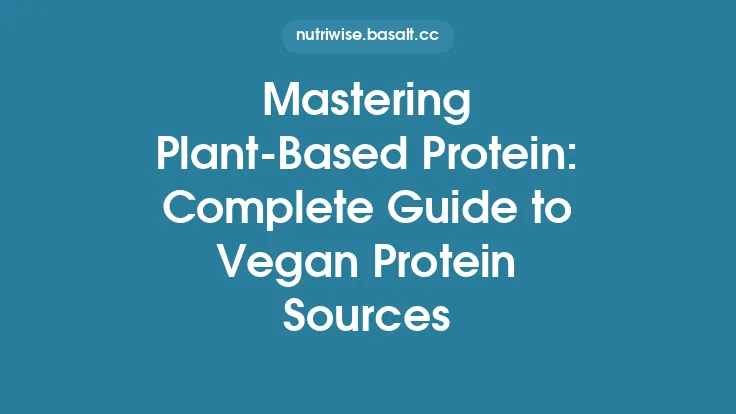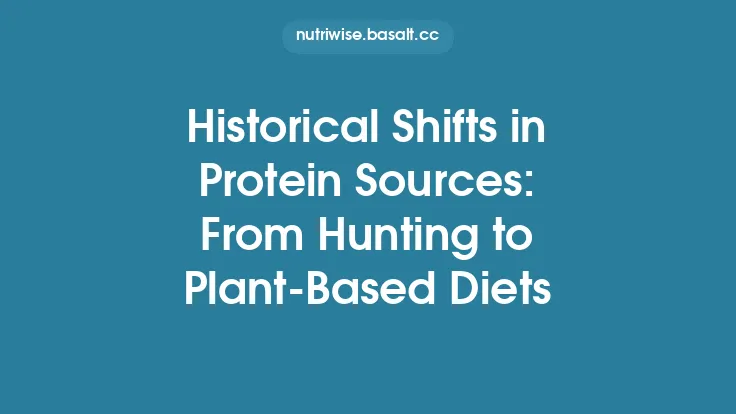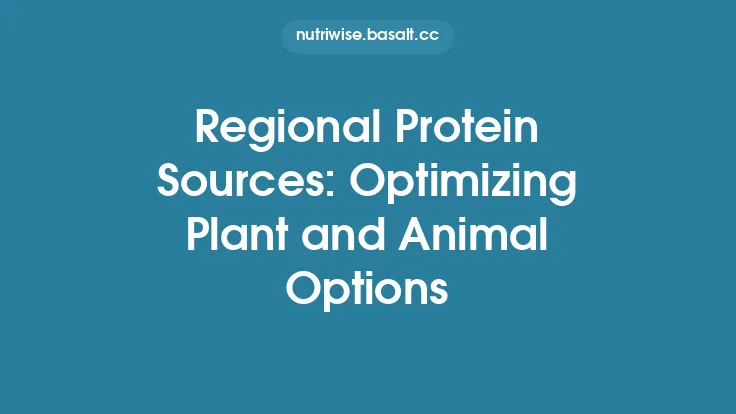Protein is the building block of every cell in the body, and its quality, timing, and source can have a profound impact on health, performance, and longevity. Yet, unlike many other nutrients that can be obtained from a relatively static pantry of staples, the foods that deliver high‑quality protein often follow the rhythm of the seasons. Farmers’ markets, coastal fisheries, and even backyard gardens shift their offerings throughout the year, and the savvy eater can turn these fluctuations into an advantage—ensuring variety, optimizing nutrient density, and supporting local economies.
In this article we explore how to adapt protein choices to what is naturally abundant at any given time of year. We’ll examine the biological reasons behind seasonal protein availability, break down the major animal‑ and plant‑based categories, discuss emerging alternatives, and provide concrete strategies for maintaining a balanced amino‑acid profile regardless of the calendar. The goal is to give you a flexible, science‑backed framework that can be applied whether you are cooking for a single household, a large family, or a professional kitchen.
Understanding Seasonal Protein Availability
Ecological drivers
The primary forces that dictate when a protein source is plentiful are climate, breeding cycles, and agricultural practices. For example, many fish species spawn in spring, making mature, fatty fillets more abundant in late spring and early summer. Likewise, grazing animals such as sheep and cattle experience peak weight gain during the lush growth of spring pastures, which translates into higher‑quality meat in the months that follow.
Supply chain lag
Even when a resource is harvested or caught, there is often a delay before it reaches retail shelves. Freezing, curing, and other preservation methods can extend the “season” of a product, but they also alter its nutritional profile—particularly the balance of essential amino acids and the presence of heat‑sensitive micronutrients. Understanding these lag times helps you decide when to prioritize fresh versus preserved protein forms.
Regional variation
What is “in season” in a temperate zone may be off‑season in a subtropical climate. Global trade has softened these differences, yet true seasonality—defined by local production and minimal transport—still offers superior flavor, lower environmental impact, and often a better amino‑acid composition because the product is harvested at its physiological peak.
Animal‑Based Proteins: Seasonal Variations
Fish and Shellfish
- Spring – Species such as salmon, trout, and whitefish finish their upstream migrations and accumulate high levels of omega‑3 fatty acids (EPA/DHA) as they build energy reserves for spawning. Their muscle tissue is rich in leucine and lysine, making them excellent for muscle protein synthesis.
- Summer – Warm‑water species like bass, catfish, and tilapia are at their most abundant. These fish tend to have slightly lower fat content but higher concentrations of histidine, which can be beneficial for histamine regulation.
- Fall – Many crustaceans (e.g., shrimp, crab) and mollusks (e.g., mussels, oysters) reach peak harvest. Their shells contain trace minerals such as zinc and selenium, and their meat is high in methionine, a sulfur‑containing amino acid critical for antioxidant pathways.
- Winter – Cold‑water fish such as cod, haddock, and pollock dominate the market. Their slower metabolism results in denser protein fibers and a higher proportion of essential amino acids per gram of flesh.
Meat and Poultry
- Grass‑fed ruminants – Cattle and sheep grazing on spring and early summer pastures develop intramuscular fat (marbling) rich in conjugated linoleic acid (CLA) and a favorable omega‑6:omega‑3 ratio. The protein from these animals contains a balanced profile of branched‑chain amino acids (BCAAs).
- Finishing phase – By late summer, many producers transition animals to grain‑based diets to achieve market weight. This shift raises the proportion of leucine and valine but can reduce the overall micronutrient density (e.g., iron, vitamin B12).
- Poultry – Free‑range chickens and turkeys that have access to seasonal insects and greens in spring and summer exhibit higher levels of taurine and carnosine, both of which support muscle contractility and antioxidant capacity.
Dairy and Eggs
- Milk – Lactating cows produce milk with a higher concentration of whey proteins (β‑lactoglobulin, α‑lactalbumin) during spring when pasture quality is optimal. This translates to a higher biological value (BV) of the protein.
- Eggs – Hens that forage on fresh greens and insects in the warmer months lay eggs with deeper yolk coloration, indicating increased lutein and zeaxanthin. While these are carotenoids rather than proteins, the associated increase in phospholipid content improves the bioavailability of the egg’s high‑quality albumin protein.
Plant‑Based Proteins: Harvest Cycles and Availability
Legumes
- Spring – Early‑season peas and broad beans (fava beans) are harvested. Their protein is rich in lysine, a limiting amino acid in many cereals, making them ideal for complementary protein pairings.
- Summer – Soybeans reach peak maturity. Whole soybeans provide a complete amino‑acid profile, with a PDCAAS (Protein Digestibility‑Corrected Amino Acid Score) of 1.0, the highest among plant foods. Fermented soy products (tempeh, miso) become more prevalent, enhancing digestibility through microbial protease activity.
- Fall – Lentils, chickpeas, and black beans are harvested. These legumes have higher fiber content (which is acceptable as long as it does not dominate the discussion) and a robust supply of threonine and isoleucine.
Nuts and Seeds
- Summer – Sunflower seeds, pumpkin seeds, and almonds are harvested. These are dense in arginine and glutamine, amino acids that support nitric oxide production and gut mucosal health.
- Fall/Winter – Walnuts, pistachios, and hazelnuts become available. Their protein is accompanied by higher levels of polyunsaturated fatty acids, which can influence the overall protein‑to‑fat ratio of a meal.
Pseudocereals and Grains
- Quinoa and amaranth – Harvested in late summer to early fall, these seeds provide a complete amino‑acid profile, particularly high in methionine, which is often limiting in wheat and rice.
- Buckwheat – Typically harvested in early fall, buckwheat protein is rich in cysteine, supporting glutathione synthesis.
Integrating Emerging and Alternative Proteins Seasonally
Insect Protein
- Seasonality – Insect farms can modulate feed composition to align with local crop residues, effectively mirroring the seasonal availability of plant protein sources. For instance, crickets raised on summer wheat straw will have a slightly different amino‑acid distribution than those fed winter rye.
Cultured (Cell‑Based) Meat
- Production cycles – While not bound to traditional agricultural seasons, cultured meat facilities often schedule batch runs to coincide with peak demand for certain cuts, allowing them to complement seasonal gaps in conventional meat supply.
Algal Protein
- Microalgae – Spirulina and chlorella can be cultivated year‑round in controlled photobioreactors, but outdoor pond systems experience seasonal fluctuations in growth rates, affecting protein yield and the proportion of essential amino acids such as lysine and threonine.
Nutritional Strategies for Balancing Protein Quality Year‑Round
- Amino‑Acid Complementation
- Pair legumes (high in lysine, low in methionine) with grains or nuts (high in methionine, low in lysine) within the same meal. Seasonal pairings—e.g., spring peas with summer barley—ensure both macro‑ and micronutrient diversity.
- Utilize Protein Digestibility Metrics
- PDCAAS and DIAAS (Digestible Indispensable Amino Acid Score) provide a more accurate picture of protein quality than crude protein content alone. For example, raw soybeans have a PDCAAS of 1.0, but heat‑treated soy may drop slightly due to Maillard reactions that reduce lysine availability.
- Leverage Seasonal Fatty‑Acid Profiles
- Fish caught in spring contain higher EPA/DHA, which can enhance the absorption of fat‑soluble vitamins and improve the utilization of certain amino acids (e.g., leucine) for muscle protein synthesis.
- Mind the Timing of Protein Intake
- Research indicates that consuming 20–30 g of high‑quality protein within a 3‑hour window post‑exercise maximizes muscle protein synthesis. Aligning this window with the availability of fresh seasonal protein (e.g., a post‑hike salmon dinner in early summer) can amplify the anabolic response.
- Consider Bioactive Peptides
- Seasonal processing methods (e.g., fermentation of soy in fall) generate bioactive peptides that may exert antihypertensive or immunomodulatory effects. Incorporating these foods can add functional benefits beyond basic protein provision.
Practical Tips for Sourcing, Storing, and Preparing Seasonal Proteins
- Farmers’ Market Planning – Visit weekly markets early in the season to secure the freshest fish, meat, or legumes. Ask vendors about the harvest date; the fresher the product, the higher the intact essential amino‑acid content.
- Batch Freezing – Portion out fish fillets, lean meats, or cooked legumes into 150‑gram servings before freezing. Rapid freezing (flash‑freeze) preserves protein structure and minimizes ice crystal formation that can damage cell membranes.
- Drying and Powdering – Dehydrate legumes or nuts during peak season and grind them into flour or protein powder. This extends shelf life while retaining most amino acids; however, be aware that high‑temperature drying can reduce lysine availability.
- Curing and Smoking – Traditional methods such as cold‑smoking salmon in summer or curing pork in fall add flavor and extend usability. These processes also concentrate protein per gram, though they may increase sodium content—balance accordingly.
- Cooking Techniques – Gentle methods (steaming, poaching) preserve delicate amino acids like tryptophan, whereas high‑heat grilling can enhance Maillard browning but may reduce certain heat‑sensitive nutrients. Rotate techniques throughout the year to diversify the nutritional profile of your meals.
Cultural and Culinary Perspectives on Seasonal Protein Use
Many culinary traditions have evolved precisely because of seasonal protein constraints.
- Mediterranean spring – Dishes such as “fava bean purée with fresh herbs” emerged when legumes were the primary protein source before the summer harvest of fish.
- Japanese autumn – The celebration of “sanma” (Pacific saury) aligns with the fish’s migration, and the high‑protein, omega‑rich fillet is traditionally grilled and served with grated daikon, a seasonal root that complements the protein’s flavor without focusing on fiber.
- Nordic winter – Preserved cod (stockfish) and reindeer meat have historically provided reliable protein during months when fresh harvests were scarce. Modern chefs reinterpret these ingredients using sous‑vide or slow‑roasting to retain protein integrity while adding contemporary textures.
Understanding these cultural contexts can inspire creative menu planning that respects both tradition and modern nutritional science.
Future Outlook: Climate Change and Seasonal Protein Supply
Climate variability is reshaping the timing and abundance of many protein sources. Warmer ocean temperatures are shifting fish spawning periods, potentially shortening the window of peak omega‑3 availability. Droughts affect pasture quality, influencing the fatty‑acid composition of grass‑fed meat. Conversely, advances in controlled‑environment agriculture (CEA) and vertical farming are beginning to decouple some plant‑based proteins from weather patterns, allowing year‑round production of soy, pea, and lentil isolates.
For the consumer, staying adaptable means:
- Diversifying protein sources – Relying on a mix of animal, plant, and emerging proteins reduces vulnerability to any single seasonal shortfall.
- Supporting resilient supply chains – Purchasing from producers who employ regenerative practices (e.g., rotational grazing, cover cropping) can help stabilize protein quality across seasons.
- Monitoring emerging data – Nutrient composition databases are increasingly updating seasonal values for protein foods; integrating these data into meal‑planning apps can fine‑tune intake.
By aligning your protein choices with the natural ebb and flow of seasonal availability, you not only optimize the nutritional quality of each meal but also foster a more sustainable, resilient food system. Whether you’re a home cook, a dietitian, or a culinary professional, the principles outlined here provide a robust framework for making informed, seasonally attuned protein decisions throughout the year.





